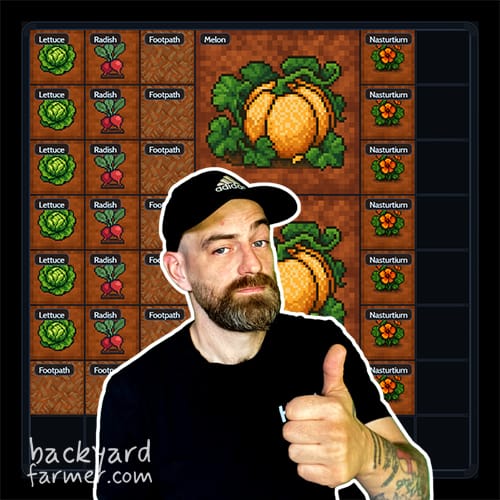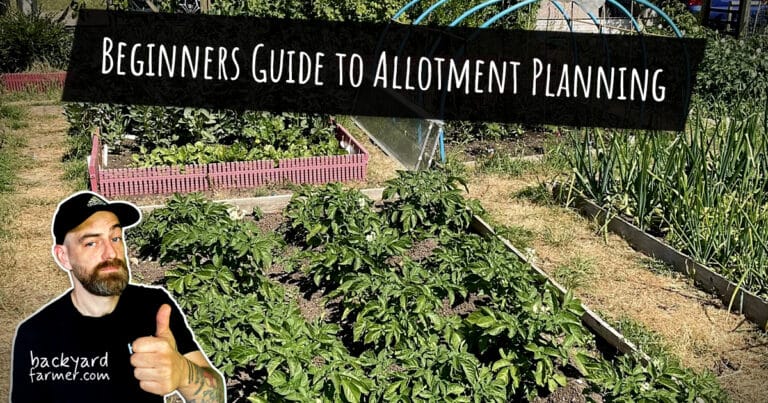Table of contents
- Introduction
- What Is Allotment Planning?
- How to Plan an Allotment (Step-by-Step)
- Allotment Layout Ideas for Beginners
- Allotment Ideas to Inspire You
- Common Allotment Planning Mistakes to Avoid
- Seasonal Allotment Calendar Overview
- How to Use The Allotment Planner App
- Free Allotment Layout Templates
- Final Thoughts
Introduction
Planning your first allotment can feel like a big leap, especially when you’re trying to visualise your future allotment layout on a bare patch of earth. With so many choices — beds, crops, tools, and endless allotment ideas — it’s no surprise most beginners aren’t sure where to start. The good news is that you don’t need to have every detail figured out on day one.

This beginner‑friendly guide walks you through how to plan an allotment in a clear, down‑to‑earth way, so you can build a plot that actually works for you. By the end, you’ll have:
- A simple way to understand your plot and its quirks
- Beginner‑friendly allotment layout ideas you can copy or adapt
- The most common allotment planning mistakes to avoid
- A straightforward plan you can follow today
To make the whole process even easier, we’ll also introduce The Allotment Planner — a free, easy‑to‑use allotment planner tool designed to help you:

- Map your plot to scale without fiddling around on paper
- Create a clean, practical allotment plan template with beds, paths, and structures
- Visualise your planting layout before you start digging
- Export your finished layout as a PDF or PNG to use directly at the allotment
When you remove the guesswork from allotment planning, everything becomes more enjoyable. Instead of stressing over measurements or spacing, you can spend more time doing the fun part: growing great food.
Let’s start with the basics and build your allotment from the ground up.
What Is Allotment Planning?
Allotment planning is the process of organising your plot so it becomes productive, manageable, and enjoyable to work on throughout the year. Rather than planting wherever there’s room, planning helps you make the most of your space, avoid common beginner mistakes, and create an allotment layout that actually fits your lifestyle.

At its core, effective allotment planning allotment planning comes down to a few simple ideas:
- Understanding your plot — including sun exposure, soil type, drainage, and overall size.
- Choosing an allotment layout that matches your goals, whether you want maximum yield, low maintenance beds, or a wildlife-friendly space.
- Planning crops and structures such as raised beds, compost bays, polytunnels, sheds, and perennial or wildlife areas.
- Timing your planting so you get steady harvests across the year rather than one big glut.
Good planning doesn’t need to be complicated. In fact, most productive plots follow straightforward, repeatable principles that beginners can learn quickly. Once you understand these basics, the rest of your allotment plan becomes far easier to manage.
Digital tools like The Allotment Planner take this even further. Instead of guessing bed sizes or scribbling rough sketches, you can build a clean, accurate allotment plan template, test different layouts, and export your final design to use directly at the allotment. It saves time, reduces mistakes, and helps you start your growing journey with confidence.
How to Plan an Allotment (Step-by-Step)
Learning how to plan an allotment becomes far easier once you break it into simple, practical steps. When you approach your plot methodically, you move from an empty patch of ground to a clear, confident allotment plan that suits your space, your budget, and the way you prefer to grow. These foundations are exactly what most beginners need to get started.
Assess Your Plot
Before sketching an allotment layout or choosing crops, take a moment to properly understand the space in front of you. This quick assessment saves confusion later and prevents many beginner mistakes.
Key things to look for:
- Sun and shade: Note which areas get full sun and which stay shaded — this heavily affects what will grow well.
- Soil type: Clay, loam, sandy, or mixed soil all drain differently and impact plant health.
- Drainage: Look for spots that stay wet after rain.
- Wind exposure: Open, windy plots may need simple windbreaks.
- Water access: Check for taps or consider adding water storage.
A relaxed 10–15 minute walk around your plot gives you everything you need to start planning effectively.
Choose Your Growing Style
Your growing style influences your overall allotment layout, workload, and crop choices. Pick an approach that suits your time, experience, and goals.
Popular options:
- No-dig beds: Low effort, fewer weeds, and healthier soil.
- Traditional rows: Straightforward for beginners and ideal for larger plots.
- Raised beds: Tidy, controlled, and perfect for poor soil.
- Mixed/polyculture beds: Great for organic, wildlife-friendly allotment ideas.
If you’re unsure, start simple. You can always adapt your allotment plan as you gain confidence.
Plan Your Paths and Access
Strong access is a key part of any good allotment layout. Without clear paths, even basic tasks take longer and become frustrating.
General path guidelines:
- 60–70 cm wide: Comfortable and practical.
- Straight or curved: Choose what feels natural and suits your design.
- Mulch or woodchip: Helps suppress weeds and keeps your footing safe.
Good paths make watering, weeding, harvesting, and general upkeep far easier.
Choose What to Grow
Once the structure is clear, you can start choosing crops and shaping the rest of your allotment plan.
Beginner-friendly crops:
- Potatoes
- Onions & garlic
- Courgettes
- Beans
- Lettuce & leafy greens
- Soft fruits (easy, reliable, and rewarding)
Basic crop rotation principle:
Avoid planting the same crop family in the same spot each year — a simple way to reduce pests and disease.
Grow what you actually eat.. Designing an allotment layout full of crops you don’t use only leads to wasted space.
Turn Your Plan Into a Layout
This is where everything comes together into a clear allotment layout plan.
Your layout should include:
- Beds (no-dig, raised, or traditional)
- Clear paths and access points
- Compost bays
- Water storage
- Perennial or fruit areas
- Optional wildlife-friendly zones
You can use pen and paper, but tools like The Allotment Planner make the job significantly easier., but tools like The Allotment Planner make the job significantly easier. Enter your plot size, drop in beds and paths, place structures, and export a clean PDF or PNG to use directly at the plot.
A simple, visual allotment planner layout helps you start confidently — and stick to a design that works all year long.vFor official guidance on allotment rights, rules, and tenancy structures, you can also visit the National Allotment Society here.
Allotment Layout Ideas for Beginners
Choosing the right allotment layout is one of the most important steps in creating a productive, easy-to-manage plot. You don’t need anything complicated — just a layout that suits your space, your time, and the way you like to grow. The ideas below are beginner‑friendly, practical, and easy to customise using The Allotment Planner, making them ideal starting points for any new grower.
Classic Four-Bed Rotation Layout
This straightforward and reliable allotment layout works for almost every beginner.
Why it works:
- Great for learning crop rotation
- Simple to maintain
- Clear structure with minimal confusion
How it’s set up:
- Four equally sized beds
- A central access path
- One bed per crop family (roots, brassicas, legumes, others)
Ideal for: beginners, mixed‑veg growers, and anyone wanting an uncomplicated allotment plan.
No‑Dig Grid Layout
Inspired by the popular no‑dig method, this layout is perfect if you want a low‑maintenance, soil‑friendly approach.
Why it works:
- Quick to set up and maintain
- Excellent weed suppression
- Improves soil structure with minimal disturbance
How it’s set up:
- Rows or grids of 1.2m‑wide no‑dig beds
- Wide woodchip or mulch paths
- Compost bays and water storage nearby
Ideal for: organic growers, low‑effort plots, and anyone searching for no‑dig allotment ideas.
L‑Shaped Perimeter Bed Layout
A flexible allotment layout idea** that places beds around the edges of your plot.
Why it works:
- Maximises central space for a shed, greenhouse, or seating
- Works well for awkward or narrow plots
- Easy to maintain with clear access routes
How it’s set up:
- Beds along two or three perimeter sides
- A central open space
- Corner areas for compost, water, or storage
Ideal for: half‑plots, smaller allotments, sociable growers, and compact growing spaces.
Half‑Plot Beginner Layout
If you’re working with a smaller allotment, this layout keeps things simple and manageable.
Why it works:
- Less overwhelming than a full plot
- Focuses on high‑yield, easy crops
- Simple crop rotation with fewer beds
How it’s set up:
- 3–4 beds with a main central path
- A small fruit section (berries, strawberries, rhubarb)
- Storage or water collection near the entrance
Ideal for: new growers, busy people, and anyone searching for beginner allotment layout ideas.
Wildlife‑Friendly Layout
This allotment design** blends food production with a space that supports wildlife, making your plot feel more alive.
Why it works:
- Attracts pollinators
- Encourages natural pest control
- Creates a relaxed, welcoming atmosphere
How it’s set up:
- Wildflower borders or a pollinator strip
- A small pond or shallow water basin
- Companion plants mixed through the beds
- Less rigid planting, avoiding overly strict rows
Ideal for: organic gardeners, eco‑friendly growers, and anyone wanting a more biodiverse allotment layout.
All these allotment layout ideas can be built, tested, and refined inside The Allotment Planner. Simply enter your plot size, arrange your beds and paths, and export your personalised allotment plan as a PDF or PNG to take with you to the plot. It’s an easy way to plan with confidence and avoid layout mistakes.
Allotment Ideas to Inspire You
Every grower’s needs are different. Some people want a plot bursting with home‑grown food, others prefer a low‑maintenance setup, and many like a mix of beauty, wildlife, and productivity. These beginner‑friendly allotment ideas will help you shape a plot that fits your lifestyle while supporting a practical and productive allotment layout.
Low‑Maintenance Allotment Ideas
Not everyone has hours each week to spend at the plot, and that’s completely fine. to spend at the plot, and that’s completely fine. These simple, low‑effort allotment ideas help you cut down on work while keeping your plot productive.
- No‑dig beds to dramatically reduce weeding
- Woodchip paths for quick, low‑upkeep access
- Mulched beds to retain moisture
- Perennial crops (rhubarb, fruit bushes, herbs) that return each year
- Automatic or gravity‑fed watering systems for hot summer months
Ideal for: busy growers, beginners, and weekend allotmenteers looking for easy allotment planning options.
Raised Bed Allotment Ideas
Raised beds create structure and control, which is why they feature in so many beginner allotment layouts., which is why they feature in so many beginner allotment layouts.
- Use reclaimed timber or pallet wood to save money
- Stick to the 1.2m standard width for easy access
- Add gravel or woodchip paths for tidy, dry walkways
- Mix bed heights for comfort and visual appeal
Ideal for: plots with tired soil, tidy growers, and accessible allotment designs.
Shed & Storage Ideas
Good storage is a huge help when keeping your allotment organised. when keeping your allotment organised.
- Compact sheds for small plots
- Hooks, shelves, and crates to maximise space
- Lockable storage boxes where sheds aren’t allowed
- Rainwater barrels attached to shed guttering for easy irrigation
Ideal for: growers who need simple, low‑cost allotment planning solutions.
Greenhouse & Polytunnel Ideas
Adding a greenhouse or tunnel can transform your growing season and works well in almost any allotment layout. can transform your growing season and works well in almost any allotment layout.
- 6×4ft greenhouses fit neatly into most UK plots
- Mini polytunnels for budget setups
- Timber or brick bases for stability
- Vents or extra doors for heat control
Ideal for: tomato growers, seed starters, and year‑round gardeners.
Budget‑Friendly Allotment Ideas
You don’t need a big budget to create a productive plot. to create a productive plot. Many great allotment ideas cost next to nothing.
- Build compost bays and bed sides from pallets
- Collect rainwater in free barrels or IBCs
- Start seeds in reused containers
- Ask local tree surgeons for free woodchip
- Swap seedlings with neighbours
Ideal for: beginners starting from scratch and anyone planning a low‑cost allotment layout.
Organic & Wildlife‑Friendly Allotment Ideas
If you want a plot that feels alive and balanced, add a few wildlife‑friendly touches into your allotment plan. and balanced, add a few wildlife‑friendly touches into your allotment plan.
- Wildflower borders or a mini meadow strip
- A small wildlife pond or shallow water dish
- Companion plants like marigolds, basil, and nasturtiums
- A log pile or simple bug hotel
- Avoid digging during bee nesting season for a healthier ecosystem
Ideal for: eco‑conscious growers and organic allotmenteers.
Use these ideas as inspiration and combine them with your personalised layout inside The Allotment Planner. Mix and match styles until you create an allotment layout that suits your space — and the way you like to grow.
Common Allotment Planning Mistakes to Avoid
Even with the best intentions, most beginners fall into the same handful of traps when setting up their first plot when setting up their first plot. The good news is that once you know what to look out for, you can avoid these issues entirely — saving time, effort, and frustration. Understanding these mistakes is a key part of good allotment planning, and fixing them early will make your whole allotment layout easier to manage.
Overcrowding the Plot
It’s tempting to plant everything at once, but overcrowding can quickly backfire and reduce productivity.
It usually leads to:
- Poor airflow
- More pests and disease
- Smaller harvests
- A plot that feels chaotic and overwhelming
Tip: Start small with a few reliable crops and expand as your confidence grows. It’s one of the simplest ways to keep your allotment plan manageable.
Ignoring Pathways
Paths might seem unimportant at first, but they make a huge difference to how well your allotment layout works.
Common issues when paths are too narrow or missing:
- Stepping on beds and compacting soil
- Difficulty reaching plants without stretching
- Wasted time weaving through awkward spaces
Fix: Aim for 60–70 cm paths so you can move comfortably and maintain your plot easily.
Planting Without a Plan
Planting on the fly usually leads to shading problems, poor crop rotation, and a layout that becomes messy fast.
Fix: Always sketch a quick allotment plan before planting. Even a simple layout helps. Tools like The Allotment Planner provide a clear visual guide and make planning far easier.
Forgetting Perennials
Perennial crops like rhubarb, herbs, asparagus, and berries stay in place for years. If you plant them randomly, they’ll disrupt your future allotment layout and limit your options.
Fix: Set aside a dedicated corner or border for perennials from the start.
Poor Water Management
Many beginners underestimate how much water their plot will need during hot months.
Common mistakes:
- No water storage
- Placing beds far from the tap
- Relying solely on communal taps during dry spells
Fix: Add water butts, IBC totes, or barrels early on. Keep high-demand crops close to your water source to streamline your allotment planning.
Neglecting Compost & Waste Areas
Without a compost system, weeds and green waste build up fast — and the plot can quickly feel untidy.
Fix: Create a simple compost bay or heap straight away. It keeps your plot organised and provides free, nutrient-rich compost that supports a healthy allotment layout.
Avoiding these common mistakes will massively improve your results. With a clear allotment plan — and a layout you can stick to — you’ll build a plot that’s productive, manageable, and enjoyable to work on throughout the year.
Seasonal Allotment Calendar Overview
A successful allotment isn’t just about where you place your beds — it also depends heavily on timing. about where you place your beds — it also depends heavily on timing. Understanding your yearly tasks helps you stay organised, avoid rushed planting, and keep your plot productive from early spring right through winter. This seasonal overview supports better allotment planning and helps you build an allotment layout that works with nature rather than against it.
Monthly Overview
Here’s a simple month-by-month breakdown to guide your allotment plan and seasonal jobs: to guide your allotment plan and seasonal jobs:
January
- Plan your allotment layout and crop rotation
- Order seeds while stock levels are high
- Repair tools, raised beds, and structures
February
- Start early seeds indoors (onions, chillies, leeks)
- Add compost to beds to prepare for spring
- Prune fruit bushes before they start growing
March
- Direct sow hardy crops
- Prepare or top up no-dig beds
- Set up water storage ahead of summer
April
- Plant potatoes
- Sow salads, carrots, beetroot, and other early staples
- Begin regular weeding as temperatures rise
May
- Plant tender crops like courgettes, beans, and squash
- Protect young plants from any late frosts
- Mulch paths and beds to retain moisture
June
- Tie in tomatoes and climbing beans
- Harvest early crops
- Increase watering as the weather warms
July
- Enjoy peak harvests
- Sow quick summer crops for fast returns
- Keep on top of weeds and watering
August
- Sow autumn and winter crops
- Take soft fruit cuttings
- Continue mulching and watering during dry spells
September
- Harvest main crops
- Clear spent plants from your allotment layout
- Save seeds from your best performers
October
- Plant garlic and overwintering onions
- Add compost and mulch for winter protection
- Cover beds where needed
November
- Tidy the plot and store tools
- Insulate taps and containers
- Repair paths or damaged structures
December
- Reflect on your year
- Update your allotment plan and layout
- Enjoy a quieter month before planning begins again
Why Your Layout Should Match the Calendar
Your allotment layout and your calendar work best when they support each other. when they support each other. When the two align, the growing year feels smoother and far more manageable.
Benefits of matching layout and calendar:
- Easier crop rotation
- Smoother sowing and harvest timings
- Better use of space
- Simpler watering routines
- A more balanced workload throughout the year
With The Allotment Planner, you can design a layout that fits your monthly tasks, add notes for seasonal jobs, and export a PDF or PNG plan you can use directly at the plot., you can design a layout that fits your monthly tasks, add notes for seasonal jobs, and export a PDF or PNG plan you can use directly at the plot. It’s one of the simplest ways to stay organised from January to December.
How to Use The Allotment Planner App
Modern allotments benefit enormously from clear, intentional allotment planning, and that’s exactly where The Allotment Planner shines. from clear, intentional allotment planning, and that’s exactly where The Allotment Planner shines. Instead of sketching rough layouts on paper or trying to visualise spacing in your head, the app gives you a clean, accurate allotment layout you can take directly to the plot.
Below is a simple walkthrough showing how this free allotment planner tool supports the entire planning process. showing how this free allotment planner tool supports the entire planning process.
Why Beginners Benefit
Starting an allotment can feel overwhelming, especially when you’re trying to organise beds, paths, crops, and storage all at once. The Allotment Planner helps remove that early confusion by:
- Removing guesswork around bed sizes, spacing, and layout
- Reducing mistakes such as overcrowding or poor path placement
- Helping you visualise your allotment layout before you lift a spade
- Keeping everything organised in one place
- Saving time with simple drag‑and‑drop controls
It’s designed for beginners, but flexible enough to grow with you as your skills and your allotment plan expand.
Key Features
The app focuses on simplicity, flexibility, and real‑world usability — ideal for anyone learning how to plan an allotment.
Core features include:
- Plot builder: Enter your plot size and shape to build a scaled workspace
- Beds and paths: Add, resize, and arrange your layout accurately
- Drag‑and‑drop elements: Position sheds, compost bays, water butts, greenhouses, and more
- Crop placement: Map where each crop will go to refine your allotment layout plan
- Companion awareness: Helps avoid poor crop pairings (optional feature)
- Export options: Save your design as a PNG or PDF for offline use at the allotment
- Clean, beginner‑friendly interface: Perfect for first‑time planners
Quick Planning Workflow
Here’s the simple workflow most beginners follow when using the app to create their allotment plan template: most beginners follow when using the app to create their allotment plan template:
- Enter your plot dimensions to generate a scaled workspace.
- Add your paths to create structure and access.
- Place your beds — no‑dig, raised, or traditional.
- Add essential features like compost bays, water storage, or a greenhouse.
- Plan your crops for each bed or section.
- Export your finished allotment layout as a PNG or PDF and take it with you to the allotment.
Because this workflow mirrors the steps in this guide, the whole planning process feels natural, structured, and beginner‑friendly.
With your layout saved and ready to use, you can begin building your plot with confidence — knowing exactly where everything belongs and how your allotment will work in practice., you can begin building your plot with confidence — knowing exactly where everything belongs and how your allotment will work in practice.
Free Allotment Layout Templates
A strong allotment layout doesn’t always need to be designed from scratch.** doesn’t always need to be designed from scratch. In fact, using templates is one of the easiest ways for beginners to build a clear, organised allotment plan while avoiding common spacing and access mistakes. These simple, ready‑made templates give you a reliable starting point and can be customised in seconds inside The Allotment Planner.
10×10 Beginner Layout Template
This compact design is ideal for small or half plots and helps you create a balanced allotment layout with minimal effort. for small or half plots and helps you create a balanced allotment layout with minimal effort.
Features:
- Four equal beds for simple crop rotation
- A central access path
- Border space for herbs, flowers, or companion plants
- Optional compost corner
Ideal for: first‑time growers and smaller allotments looking for a simple allotment plan template.
5×20 Half‑Plot Template
This long, narrow template suits many standard UK half‑plots and creates a tidy, productive allotment layout without overcrowding. suits many standard UK half‑plots and creates a tidy, productive allotment layout without overcrowding.
Features:
- Three long growing beds
- A perennial strip for rhubarb or berries
- A main central path
- Space near the entrance for water collection or storage
Ideal for: beginners wanting a low‑maintenance yet efficient allotment layout.
No‑Dig Layout Template
Based on the no‑dig method, this layout keeps maintenance low and soil health high — ideal for organic‑minded growers., this layout keeps maintenance low and soil health high — ideal for organic‑minded growers.
Features:
- Rows of 1.2m‑wide no‑dig beds
- Wide woodchip paths for easy access
- A compost bay located at one end
- Mulched borders to suppress weeds and retain moisture
Ideal for: organic growers, beginners exploring no‑dig allotment ideas, and anyone wanting minimal digging.
Raised Bed Grid Template
A clean, structured grid layout for growers who prefer clearly defined spaces in their allotment design. for growers who prefer clearly defined spaces in their allotment design.
Features:
- A tidy grid of 1.2m raised beds
- Woodchip or gravel paths for neat access
- A corner bed for flowers, herbs, or wildlife‑friendly planting
- Optional central feature such as a water butt, barrel, or mini shed
Ideal for: tidy growers, family‑friendly allotments, and wheelchair‑accessible layouts.
All these templates can be recreated, customised, and exported as a PNG or PDF inside The Allotment Planner. can be recreated, customised, and exported as a PNG or PDF inside The Allotment Planner. Whether you copy them exactly or mix and match sections to suit your space, using templates makes allotment planning quicker, easier, and far more accurate.
Final Thoughts
Good allotment planning doesn’t need to feel complicated.** doesn’t need to feel complicated. With a clear allotment layout, a handful of reliable ideas, and a basic understanding of your seasonal tasks, you can turn an empty plot into a productive and enjoyable space that grows food throughout the year. Once you take that first step, everything becomes far easier.
The key is to keep your first allotment plan simple: allotment plan simple:
- Focus on an allotment layout you can genuinely maintain
- Choose easy, dependable starter crops
- Avoid overcrowding early on
- Add new features gradually as your confidence grows
It’s also worth remembering that every allotment — even those run by very experienced growers — evolves year after year. that every allotment — even those run by very experienced growers — evolves year after year. You learn as you go, refine your layout, and discover what works best for your space. That’s all part of the fun.
If you want a straightforward way to bring everything together, The Allotment Planner makes the whole process smoother. to bring everything together, The Allotment Planner makes the whole process smoother. You can map your plot to scale, arrange beds and paths, create a clean allotment plan template, and export your layout as a PDF or PNG to take with you onto the plot. It keeps your ideas organised, visual, and easy to follow.
With a solid, realistic plan in place, you’re ready to start building a plot that’s productive, manageable, and uniquely your own. in place, you’re ready to start building a plot that’s productive, manageable, and uniquely your own.
Happy growing — and enjoy the journey ahead!





